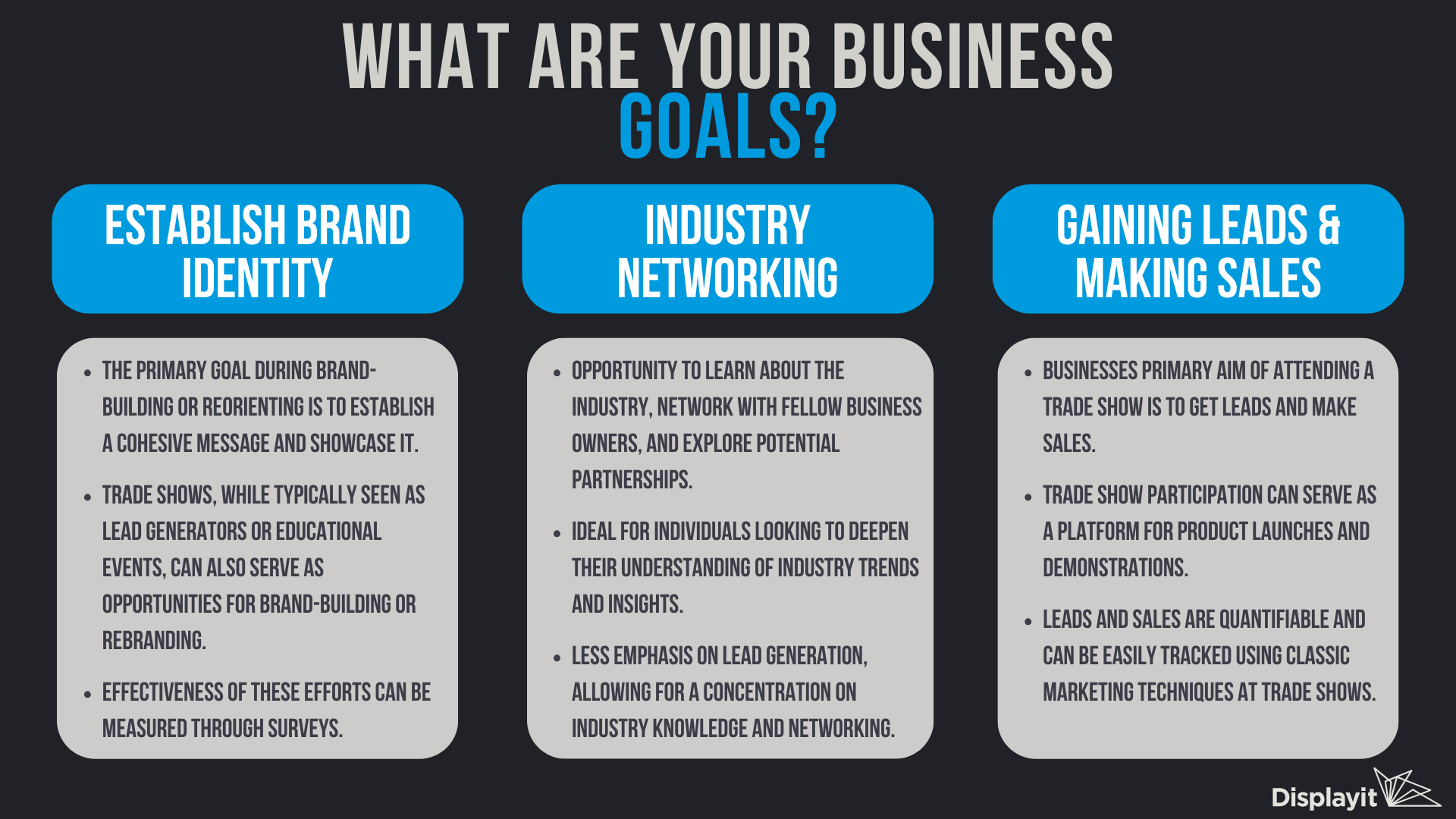Attending or exhibiting at a trade show can be a lot of fun, but what really makes a show worthwhile is achieving the goals that you set for your experience.
For exhibitors (especially those exhibiting at a trade show for the first time) this can be a bit of a challenge—what are you hoping to get out of your show? How do you know that you’ve achieved it?
To help you get the most out of your next show, we’re breaking down what makes a good set of goals for a trade show and how to track whether you’ve reached them using dependable marketing techniques.

Identify Your Business Goals
First thing’s first—your trade show goals should always be based on the goals you have for your overall business. Far too often, businesses will invest in events or exhibitions without having a good handle on where their business is going and what they’re hoping to achieve in the long term.
Without a long-term direction, short-term steps (like attending a trade show) just won’t be effective. To make sure you avoid that pitfall, try thinking through strategic business goals like these:
Brand-Building & Rebranding
For most businesses (especially small businesses) brand recognition is something you can be constantly improving. Even if you have good brand recognition, you might be interested in redefining/reorienting your brand identity.
When brand-building or reorienting is your business's priority, a trade show doesn’t have to be an event that generates a ton of leads or teaches you lots about your industry. Instead, you should be looking to establish a cohesive message and show it off. You can even track whether or not those efforts were effective through surveys, something we’ll talk about later on.
Networking
For businesses that have a good brand identity and are generating decent leads outside of trade shows, a trade show might be a place to learn about your industry, to network with fellow business owners, and perhaps to seek out partnerships that can help improve your business model.
Trade shows often include workshops, keynote speakers, and other fun events that can be helpful to anyone wanting to learn more about the ins-and-outs of industry trends. If that sounds like you, you can worry less about lead generation and your booth’s unique branding and focus more on education and interpersonal relationship building.
Gaining Leads & Making Sales
Lastly, there’s the goal that most businesses think of as the primary aim of attending a trade show: getting leads and making sales. For any business, this might be an end goal, but as we’ve seen with our prior two possible goals, it’s not the only thing you should set your sights on.
That being said, if your branding and industry know-how are in order, a trade show might be the perfect place to hit the ground running and sell! Since leads and sales are always recorded and quantifiable, this is also one of the easiest goals to effectively track using classic marketing techniques.

Get the Data!
After you’ve figured out your strategic business goals, it’s time to attend your show, achieve what goals you can, and monitor whether or not you’ve reached them.
This requires data—the better you are at acquiring data from your show and analyzing the data you’ve got, the better you’ll be at setting and achieving goals that are attainable and worthwhile. Doing this well takes years of experience, but with the right tools and techniques, you can make this process a whole lot easier.
Identify Important Metrics
As we’ve mentioned, every business will have different goals going into each show, and each of those goals will have different metrics associated with them.
Metrics for businesses who have a more abstract goal like ‘introducing a new brand identity’ won’t look quite the same as metrics for those who are just hoping to make sales on the trade show floor—but how do you know what data to gather? To make this a bit easier, here are two terms to know:
- Hard Data: This is the sort of data that is immediately ‘quantifiable’: recorded, collected, and analyzed numerically.
For businesses just looking to get leads, most of the data they acquire and use will be hard data: how many leads did they get at their show? How many leads turned into sales? How much money was brought in?

- Soft Data: This is data that is ‘qualitative’: not numerical, but related to the qualities of something. If people feel like your brand seems old, that’s not easy to quantify, but it’s still hugely important to record and remember!
Measuring whether you’ve succeeded in establishing your brand might require giving booth visitors a brief questionnaire about how they feel about your brand and services. Similarly, you could interview your own employees about whether they learned a lot from their recent show or event.
Use Tried-and-True Marketing Tools
Once you’ve determined what data might be helpful for your goals—whether that’s the number of sales, qualitative visitor responses, employee feedback, or something else—you can start implementing tools to acquire and use that data effectively.
There are so many things you can do with the content of your trade show booth, and those possibilities are expanding all the time, but in general, the three things you should be sure to include are a hook (or activity), an exit survey, and a follow-up plan.
Bring Them In: Activities & ‘Hooks’
One of the best ways to measure the success of your booth is to set up an activity that will engage visitors. The number of people who engage with that activity is an easily identifiable bit of ‘hard data’.
For example, if you set up a ‘spin the wheel’ style game where visitors can try for a prize, but every participant gets a small keychain or business card, you can quickly count the number of keychains/business cards given out to measure how many people participated.
Finish Strong: Exit Surveys
Once you’ve interested visitors and made some connections, you’ll want to leverage your connection as quickly as you can to get some strong ‘soft’ data about their experience.
On the day of your show, this could look like a pen-and-paper exit survey for booth visitors—after your show’s done, you could even finish up your follow-up marketing efforts with an online survey.
Depending on your business’s goals, you can ask questions like:
- How interested were you in this or that service?
- How likely would you be to recommend our company to a friend?
- What do you think separates our services from our competitors’?
Those sorts of questions provide valuable qualitative insight into how your business is connecting with potential customers.
Follow Up: Email Marketing Campaigns
After you’ve finished your show, it’s time to solidify your relationship with visitors if you can.
A limited-duration email marketing campaign that follows up with visitors from the event, for example, can give visitors an easy, low-hassle way to keep up with your brand, while also giving you a good idea of how many people were interested enough in your activities and services to stay connected.
Email marketing campaigns also come with great opportunities to measure user engagement—with the right software, you can monitor how many people engage with your newsletter, how much time they spend reading your content, and other valuable data.
Analyze the Results
Once you’ve set your goals, attended your trade show, and collected the data you need, you can figure out whether or not you achieved the goals you hoped for!
You can compare your goal numbers to your actual numbers, compare your ‘hard data’ performance at trade shows over time (through things like visitor engagement or number of leads generated year over year), and analyze your ‘soft data’ (like whether visitors thought what you hoped they would about your brand, or whether your employees learned what they wanted to learn about your industry).
Set Your Next Goal
Once you’ve taken a look at your results, you can see what room you have to grow!
It’s great when a business meets all the goals they set, but that’s not always possible. Based on the information you have, you may want to tweak your goals a little bit from next year.
If you have something more you want to achieve, all that’s left is to construct a new strategy, figure out what metrics you’ll want to look for to determine your success, and have fun at your next show!
Meet Your Trade Show Goals With Displayit
Ready to get the results you need at your next show? Our custom trade show displays are designed to help you meet and achieve your goals
OR




